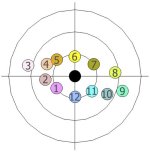A
Alaninga
Guest
sorry, was unable to reply after changing my email address,....thanks Wilber!..now..
OK, the non variables:
Barrel is LOCKED in a block that is recoil proof, or at least won't angle out of line [if any movement, straight back].
Barrel is LEVEL.
Just consider the barrel has NO sights.
I've decided the effects are so minimal that any 'lift' would be caused by factors so small as to be inconsequential.
The effect I was considering is like a toy 'Track Ball' or a baseball curving UP when sent with it's bottom spinning forward. More friction on the bottom and less friction on top as it penetrates air ahead of it's self. Now apply this principle, or effect, to a CROSSWIND hitting a bullet in flilght.
I was wondering if any 'lift' would be created by a crosswind creating more/less friction on the SIDE of a bullet. All forward movement not considered as it shouldn't have any effect on the cross wind effects.
I've solved this pretty easily. I stopped thinking about it and poured some Glenmorangie in a glass with a few small ice cubes. Now it doesn't seem so important....LOL~!
Anyway I web searched this topic of 'any' effect on a bullet causing it to have 'lift'. Spiral and yawl were common topics of discussion, but probably just modify the falling trajectory of the bullet.....sip.....sip.
Conversations on this topic caused some consternation on some forums, so, for now let's just ponder it and think: 'wow, that's amazing' LOL.
OK, the non variables:
Barrel is LOCKED in a block that is recoil proof, or at least won't angle out of line [if any movement, straight back].
Barrel is LEVEL.
Just consider the barrel has NO sights.
I've decided the effects are so minimal that any 'lift' would be caused by factors so small as to be inconsequential.
The effect I was considering is like a toy 'Track Ball' or a baseball curving UP when sent with it's bottom spinning forward. More friction on the bottom and less friction on top as it penetrates air ahead of it's self. Now apply this principle, or effect, to a CROSSWIND hitting a bullet in flilght.
I was wondering if any 'lift' would be created by a crosswind creating more/less friction on the SIDE of a bullet. All forward movement not considered as it shouldn't have any effect on the cross wind effects.
I've solved this pretty easily. I stopped thinking about it and poured some Glenmorangie in a glass with a few small ice cubes. Now it doesn't seem so important....LOL~!
Anyway I web searched this topic of 'any' effect on a bullet causing it to have 'lift'. Spiral and yawl were common topics of discussion, but probably just modify the falling trajectory of the bullet.....sip.....sip.
Conversations on this topic caused some consternation on some forums, so, for now let's just ponder it and think: 'wow, that's amazing' LOL.
Last edited by a moderator:





